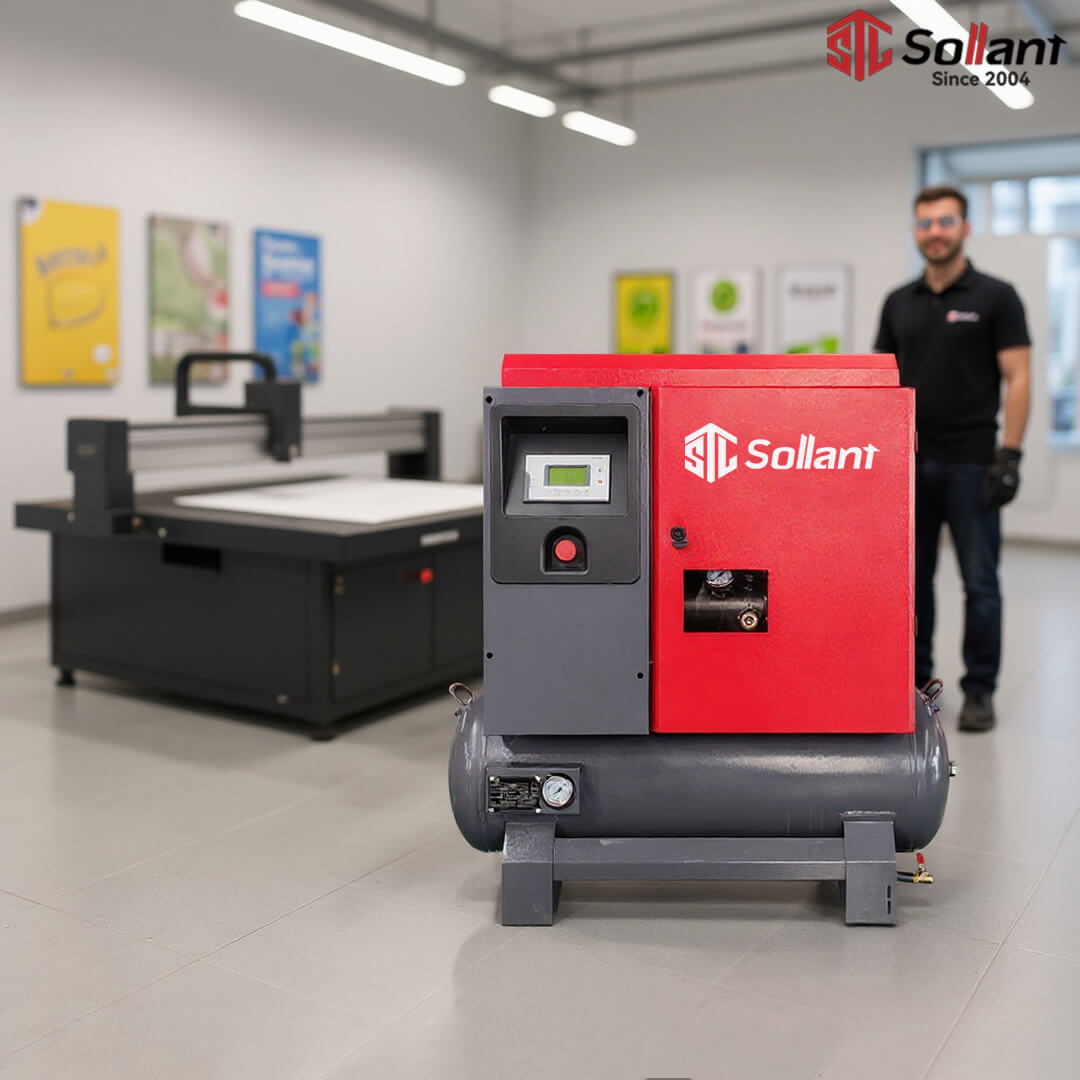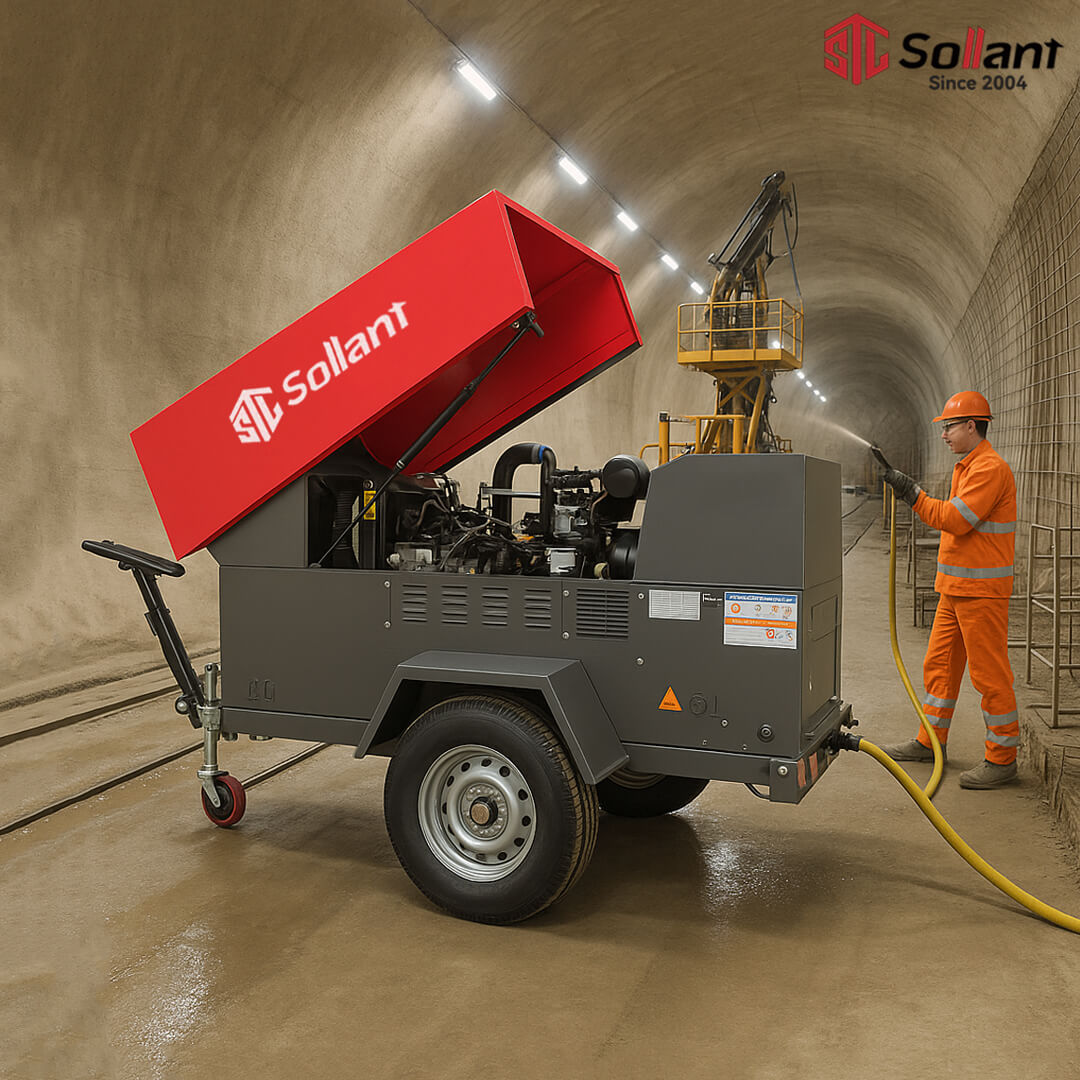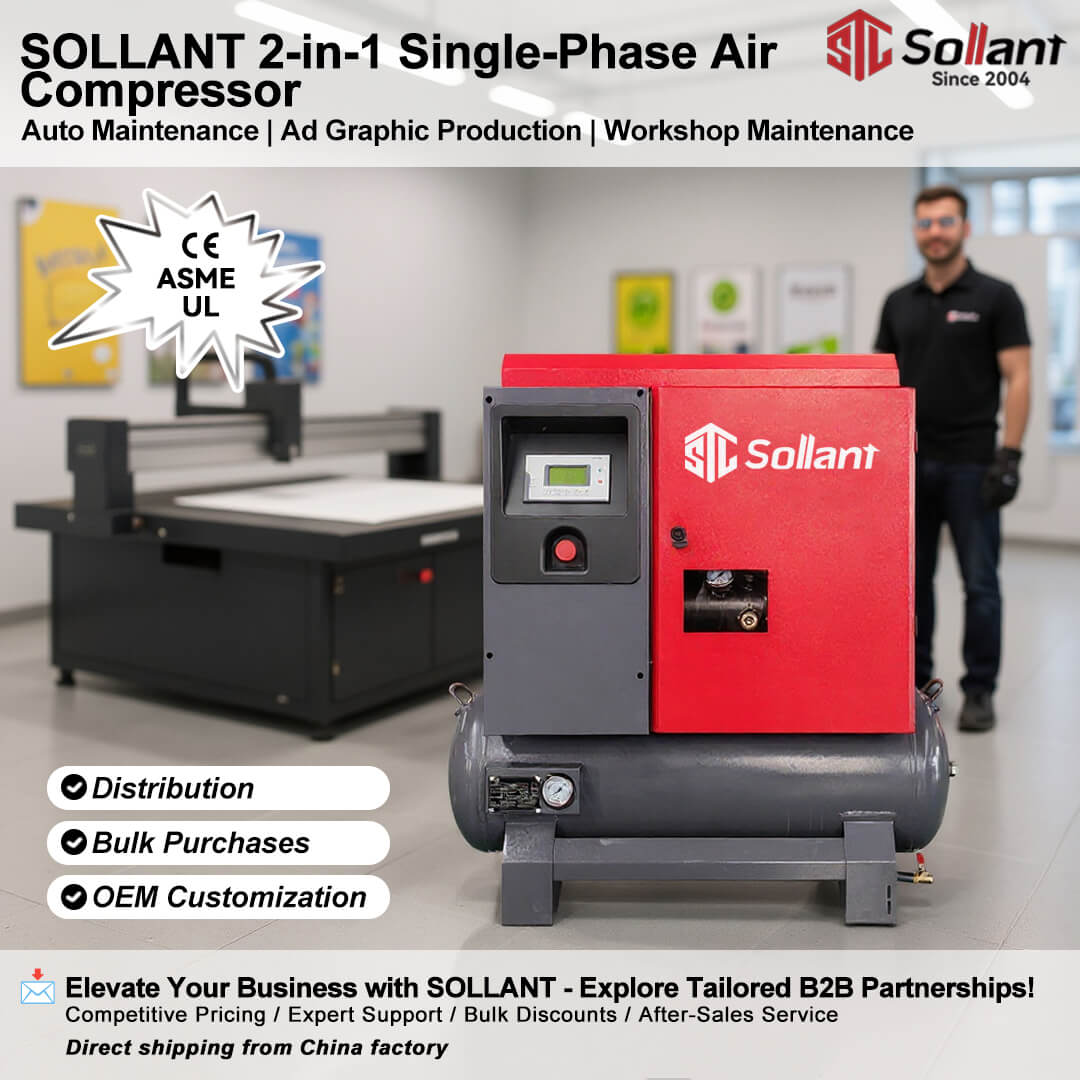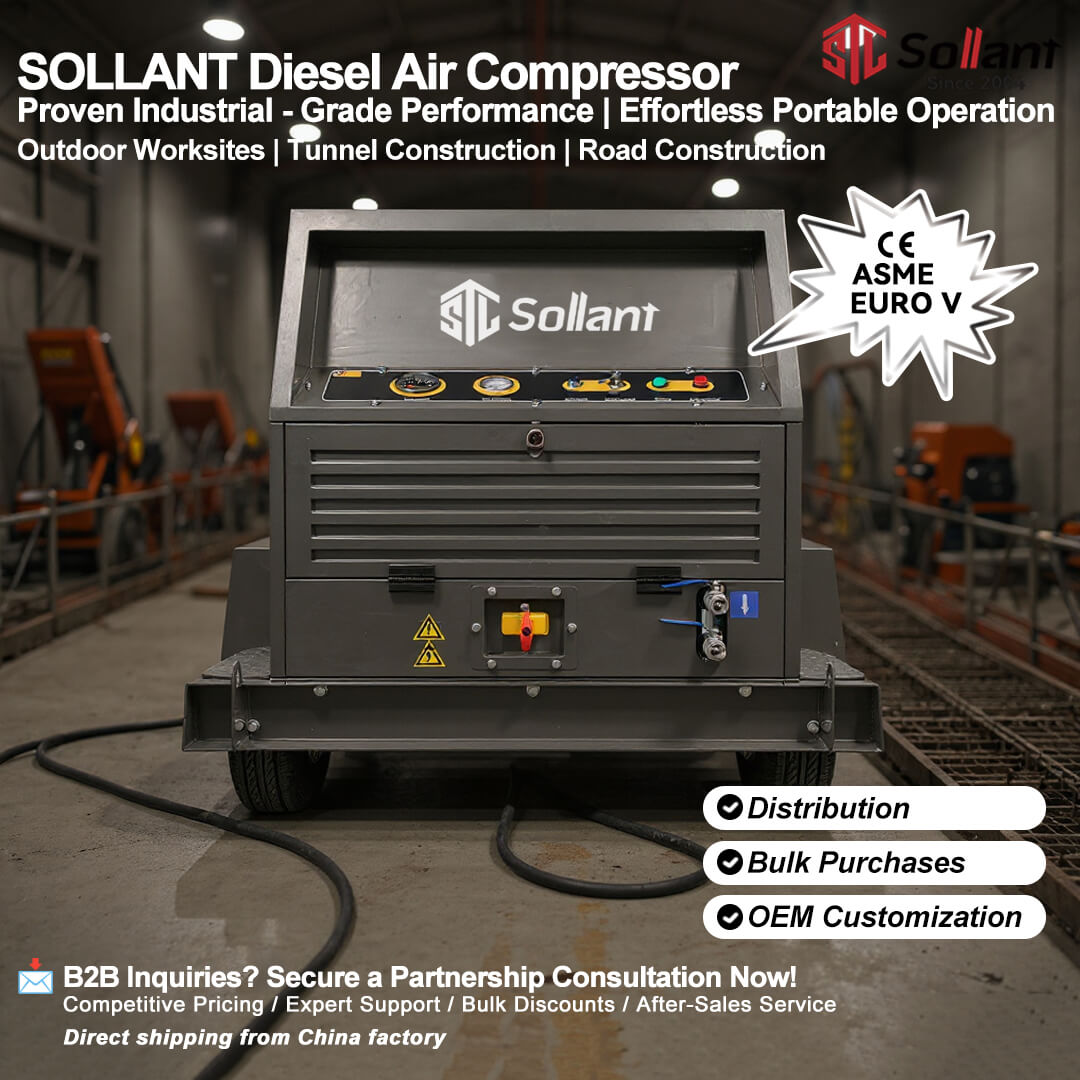How to Avoid Common Air Compressor Installation Mistakes

Imagine you finish a new air compressor installation, only to face leaks, loud vibrations, or costly downtime weeks later. Many operators skip critical steps in the installation procedure, risking both safety and efficiency. You avoid these pitfalls by following a step-by-step guide and using expert installation tips. Proper installation of your compressor—including selecting the right location, ensuring clean surroundings, and conducting regular maintenance—directly impacts equipment lifespan and performance. When you choose Sollant rotary screw compressors, you upgrade operations with expert air compressor systems installation and benefit from a successful air compressor system installation. Take care with every air system installation to maximize reliability and minimize repair costs.
Table of Contents
Key Takeaways
Choose the right location for your air compressor. Ensure it is clean, dry, and well-ventilated to enhance performance and longevity.
Plan for adequate space around your compressor. This allows for maintenance access and future expansion, reducing operational costs.
Prioritize electrical safety by using dedicated circuits and proper grounding. This prevents overheating and electrical hazards.
Implement regular inspections and maintenance schedules. This helps catch issues early and extends the lifespan of your compressor.
Follow best practices for piping and connections. Ensure airtight seals and proper drainage to maintain efficiency and prevent leaks.
Optimal Air Compressor Installation Site
Choosing the proper location for your air compressor systems is the first step in a successful installation procedure. Sollant recommends a step-by-step guide to help you avoid common hazards and maximize energy efficiency. You need to consider space, ventilation, and cleanliness to ensure your air compressor installation supports long-term reliability and performance.
Space and Expansion
When planning your air system installation, you must leave room for service and future growth. Sollant’s installation tips emphasize the importance of good access to the machine and space for expansion. You should never crowd your compressor or block maintenance paths.
If you ignore space planning, you risk higher operational costs and complicated maintenance. The table below shows how inadequate space affects your air compressor systems:
Issue | Consequence |
|---|---|
Increased energy consumption | Higher operational costs |
System pressure loss | Complicated maintenance efforts |
Decreased air quality | Potential equipment failure |
Premature equipment failure | Increased replacement costs |
Sollant’s commitment to reliability means you get a compressor room designed for easy access and future upgrades. You should always plan for extra space around your compressor to allow for expansion and leave room for service.

Ventilation and Temperature
Proper ventilation is essential for optimal air compressor installation. You need extra ventilation to keep your compressor room cool and dry. Sollant recommends maintaining the ambient temperature within the manufacturer’s range for reliable operations.
Keeping the compressor room within the manufacturer’s specified operating temperature range is critical for reliable operations and equipment life. Ideally, ambient temperatures should remain above freezing and below 105°F.
The optimal temperature for the compressor room should be 50–85℉. If your air compressor runs in a room outside this temperature range, it will be working hard to keep up, causing the lubricants to break down more quickly.
Providing enough air circulation and ventilation is also very important as this will help reduce escalating temperatures in the air compressor room, ensuring that the unit does not experience heat related issues or shutdowns due to overheating.
Poor ventilation can lead to overheating and system failure. You should follow these best practices:
Poor ventilation restricts airflow, which is essential for cooling the compressor.
Without adequate ventilation, heat cannot dissipate effectively, leading to increased temperatures.
Insufficient ventilation can result in system failure due to overheating.
Ensure there is enough space around the compressor for proper airflow.
Implement crossflow ventilation to maintain lower ambient temperatures.
Consider a mechanical exhaust system to remove hot air and a makeup air system to introduce cool air.
Sollant’s air compressor systems are designed for energy efficiency and reliability, but you must provide a compressor room with extra ventilation and temperature control to protect your investment.
Clean and Safe Environment
Selecting a clean and safe environment for your air compressor systems helps you avoid hazards and contamination. You should keep the compressor room free from dust, dirt, and harmful gases. Sollant recommends placing your air compressor in a location with clean air intake and using filters if necessary.
Ambient Air Cleanliness: Ensure the air intake is not contaminated with dust and dirt, as this can lead to maintenance issues and contamination in the air supply. Consider placing the compressor in a location with access to clean air or using ducting and filters if necessary.
Noise and Vibration Levels: Evaluate the compressor’s location to minimize noise exposure to employees, as excessive noise can affect productivity and employee satisfaction.
Regular inspections and maintenance keep your air compressor systems safe and efficient. You should:
Consider air compressor location: Ensure the air system is in a well-ventilated, clean, dry space to avoid harsh fumes, rust, and electrical issues.
Double check equipment is off before servicing.
Let air compressor cool down before maintenance.
Regularly drain the compressor tank to prevent rust and explosions.
Be mindful of hair, hands, and clothing near moving parts.
Protect your ears and eyes from noise and debris.
Secure tools and hoses before powering on air compressor.
Do not use PVC pipe for compressed air applications.
Always keep safety top of mind.
You should conduct routine inspections to identify leaks and wear, keep air intake areas clean, replace filters regularly, and maintain cooling systems. Sollant’s air compressor systems support your efforts to maintain a clean and safe environment, helping you avoid hazards and extend equipment life.
By following Sollant’s best practices for optimal air compressor installation, you create a compressor room that supports reliability, energy efficiency, and safety. You ensure good access to the machine, extra ventilation, and a clean environment, setting your air compressor systems up for long-term success.
Power Supply and Electrical Safety
Electrical safety forms the backbone of every successful air compressor installation. Sollant’s step-by-step guide ensures you avoid common mistakes by focusing on stable power supply, correct wiring, and robust grounding. You protect your compressor, your team, and your investment by following these essential installation tips.
Correct Voltage and Wiring
You must verify that your compressor receives the correct voltage at its location. Sollant recommends checking the main power supply and ensuring voltage drop does not exceed 5% of the rated value. Incorrect voltage can cause several operational issues, as shown below:
Operational Issues | Causes |
|---|---|
Difficulty in starting | Insufficient voltage |
Automatic shutdown | Insufficient voltage |
Abnormal vibrations | Insufficient voltage |
Pay attention to your air compressor voltage. If you need repairs, always power down the machine and lock out all power sources before releasing pressure. Proper wiring prevents electrical faults and supports the long-term reliability of your compressor.
Dedicated Circuits
A dedicated circuit for your compressor is essential. Shared circuits can lead to overheating, frequent breaker trips, and even electrical fires. You reduce these risks and ensure stable performance by installing a dedicated circuit. Consider these key points:
Electrical safety and fire prevention: Overloading a shared circuit can cause overheating or fires.
Enhanced performance: A dedicated circuit provides stable voltage, supporting compressor efficiency.
Compliance: Dedicated circuits help you meet NEC and local code requirements.
Sollant’s installation tips always include using dedicated circuits to protect your air compressor and maintain safe operations at your location.

Grounding and Protection
Proper grounding is critical for every compressor installation. You must connect the compressor to a real ground using a copper rod or plate, never through water pipes or drainage systems. Improper grounding increases the risk of electrical hazards and fire. Follow these guidelines:
Ensure the compressor is properly grounded at the panel.
Use a certified electrician for all electrical work.
Keep the compressor away from flammable materials and heat sources.
Plug the air compressor into a grounded outlet to protect the electrical panel and reduce fire risk.
Sollant’s commitment to safety and reliability means you receive expert support for every aspect of air compressor installation. By following these steps, you create a safe, efficient, and compliant environment for your compressor.
Air Compressor Mounting and Stability
Proper mounting and stability play a crucial role in the performance and longevity of your air compressor. Sollant’s installation tips help you avoid common mistakes and ensure your compressor operates smoothly from day one.
Level Surface
You should always place your compressor on a level, stable surface. A flat cement floor provides the best foundation for your air compressor. This placement prevents unwanted movement and keeps the compressor balanced during operation. If the surface is uneven, the compressor may vibrate excessively or shift, leading to premature wear and possible safety hazards. Sollant recommends checking the floor’s levelness before installation. Use a spirit level to confirm accuracy. A solid base supports the compressor’s weight and helps maintain proper alignment for all components.
Vibration Control
Vibration can cause significant wear and noise in your compressor system. You can reduce these issues by following proven vibration control methods:
Install a vibration isolator between the compressor and its foundation. This elastic connection absorbs movement and lowers vibration amplitude.
Use a vibration isolation joint suspension foundation. Suspending the foundation helps prevent vibration from transferring to the ground.
Create a vibration isolation groove by trenching around the compressor base. This interrupts surface wave vibrations.
Control pipe vibration by adjusting pipe length, adding orifice plates, using soft hose connections, elastically fixing pipes, setting buffer silencers, and wrapping tubing with damping materials.
These steps help you protect your air compressor and extend its service life. Sollant’s compressors are designed for stable placement and easy integration with vibration control solutions.
Noise Reduction
Noise reduction is essential for a safe and comfortable work environment. You can lower noise levels by using sound-absorbing panels and proper flooring in your compressor room.
Sound-dampening materials, such as foamboard or acoustic panels, absorb and dampen sound waves.
Sound blankets placed over the compressor enclosure or hung on walls further reduce noise.
Soft, porous materials lower ambient noise and shorten reverberation time.
Proper flooring, like smooth cement, helps prevent noise from amplifying.
Tip: Insulate your compressor room with these materials to create an ideal industrial noise control environment.
Sollant recommends these noise reduction strategies for every air compressor installation. By focusing on stable mounting, vibration prevention, and noise control, you ensure your compressor operates efficiently and quietly. Careful placement and the right materials protect your investment and support a productive workspace.
Air Piping and Connections
Proper air piping and connections play a vital role in the performance and reliability of your compressor system. You need to follow best practices during air compressor installation to minimize pressure loss and ensure airtight connections. Sollant recommends a systematic approach to layout, valves, meters, and leak testing for every compressor setup.
Layout and Slope
You should design your piping layout to support efficient airflow and easy drainage. A well-planned system helps your compressor deliver consistent air pressure and reduces maintenance needs. Follow these guidelines for optimal results:
Use gentle curves and gradual bends instead of sharp angles. This prevents turbulence and pressure drops in your air compressor system.
Maintain a slope of 1/100 to 3/100 in the direction of airflow. This slope allows moisture and condensate to drain away from the compressor.
Equip pipes with drainage points to remove water and oil sludge. Proper drainage protects your compressor and extends its service life.
Choose the correct pipe diameter. Undersized pipes increase pressure loss and reduce airflow, which can lead to blockages.
Sollant’s installation tips emphasize the importance of a clean, efficient piping layout. You create a reliable air compressor system by following these steps.
Valves and Meters
Valves and meters help you control and monitor your compressor’s performance. You should install shutoff valves between the compressor and the air storage tank. This setup allows you to isolate sections for maintenance without affecting the entire system. Backup lines on each filter line ensure continuous airflow during filter maintenance.
Pressure and flow meters must be easy to read and sized correctly. Place them where operators can clearly see the indicated pressure. The pressure scale should keep the operating pressure between half and two-thirds of the dial range. These measures help you maintain safe and efficient compressor operation.
Leak Testing
Leak testing is essential for every air compressor installation. You need to check all joints and connections for leaks before starting regular operation. Industry standards require you to maintain test pressure for at least 30 minutes with no perceptible drop. For shorter piping runs, you should pressurize and inspect connections using noncorrosive leak-detecting fluid.
Requirement | Description |
|---|---|
Length of Piping | Greater than 50 adjoining feet must be pressure tested after isolation. |
Test Pressure | Must be held for at least 30 minutes with no perceptible drop in pressure. |
Gauge Requirements | For tests ≤ 100 psi, gauges must increment by 1 psi; for tests > 100 psi, increments must be < 2% of test pressure. |
Length of Piping (≤ 50 ft) | Must be pressurized and inspected; connections tested with noncorrosive leak-detecting fluid. |
You should examine all joints and maintain pressure for a minimum of 10 minutes before reducing to design pressure. Leak-free connections ensure your compressor operates efficiently and safely.
Sollant’s expertise in air compressor systems supports your efforts to achieve airtight connections and reliable performance. By following these installation tips, you protect your investment and maintain optimal compressor operation.

Safety Measures in Installation
When you install an air compressor, you must prioritize safety at every step. Sollant’s approach to air compressor installation centers on protecting people, equipment, and your facility. You reduce risks and ensure reliable operation when you build in safety from the start. This section covers essential fire protection, emergency access, and compliance with standards to help you avoid hazards and keep your team safe.
Fire Protection
Fire protection stands as a critical part of any compressor room. You need to follow strict guidelines to prevent fires and respond quickly if one occurs. Sollant recommends placing carbon dioxide or powder fire extinguishers near the compressor but outside the danger zone. The manual switch for the extinguisher should remain easily accessible.
National safety codes require several fire protection measures for air compressor installations. The table below summarizes key requirements:
Requirement | Description |
|---|---|
UL 1450 Testing | Air compressors must pass UL 1450 tests to ensure reliability for fire systems. |
Dedicated Electric Circuit | NFPA 13 requires a dedicated circuit, installed according to NFPA 70. |
Individual Air Maintenance Device | Each dry pipe or pre-action system needs its own device unless the compressor provides less than 5.5 CFM. |
Testing Requirements | Compressors must refill the system within 30 minutes and avoid overheating. |
You should never store flammable materials near the compressor. Keep the area clean and free of debris to reduce fire hazards. Regularly inspect fire extinguishers and replace them as needed. These steps protect your equipment and the safety of service technicians.
Emergency Access
You must plan for emergencies before they happen. Sollant’s safety philosophy includes clear emergency protocols and easy access to exits and controls. Every compressor room should have a written emergency plan that lists roles and evacuation procedures. Mark fire exits and place emergency stop buttons where everyone can reach them quickly.
Key emergency access measures include:
Prepare a written emergency plan with roles and evacuation steps.
Mark fire exits and emergency stop buttons clearly.
Train all workers on the emergency plan and hold regular drills.
The table below highlights best practices for emergency access:
Safety Measure | Description |
|---|---|
Emergency Action Plans | Draft plans for fires, gas leaks, and other hazards. |
Procedures for Emergencies | Include steps for high-pressure ruptures and injuries. |
Training and Drills | Conduct walk-throughs and simulations to prepare your team. |
You reduce the risk of injury and confusion during emergencies when you plan ahead. Keep all pathways clear to avoid tripping hazards. Good emergency access supports the safety of everyone in the compressor room.
Compliance with Standards
You must follow all relevant safety standards during air compressor installation. Sollant’s commitment to safety means you receive guidance that meets or exceeds industry requirements. Always install the compressor according to electrical safety standards and ensure proper placement for easy access and maintenance.
Follow these key guidelines:
Adhere to national and local safety codes for installation.
Use proper grounding and dedicated circuits for electrical safety.
Place the compressor in a location that allows for safe maintenance and ventilation.
You protect your investment and your team when you comply with safety standards. Sollant’s air compressor systems help you build in safety from the ground up, reducing safety hazards and supporting long-term reliability.
Tip: Never skip safety checks or ignore warning signs. Regular inspections and strict adherence to standards keep your compressor running safely and efficiently.
By following these safety measures, you create a secure environment for your air compressor and everyone who works with it. Sollant stands ready to support your safety goals with reliable products and expert advice.

Maintenance and Service Access
Proper maintenance and service access start with smart planning during installation. Sollant recommends that you design your compressor area for easy access, regular inspections, and accurate record keeping. This approach supports long-term reliability and cost savings for your air compressor system.
Clearance and Accessibility
You need to provide enough space around your compressor for safe and efficient maintenance. Sollant suggests a minimum of three feet of clearance on all sides. This space allows technicians to move freely, open doors fully, and reach every component without obstruction. When you follow these guidelines, you make inspections, repairs, and preventive air compressor maintenance much easier.
Maintain at least three feet of clearance on every side.
Ensure doors and panels can open completely.
Keep pathways clear for quick access during emergencies.
Regular Inspections
Routine inspections help you catch issues before they become costly problems. Sollant recommends that you follow a schedule based on your compressor type. For rotary screw compressors, perform preventive maintenance every 2,000 to 4,000 operating hours or at least once a year. For reciprocating compressors, schedule service every 500 to 1,000 hours. Regular checks keep your air compressor running smoothly and extend its lifespan.
Inspect rotary screw compressors every 2,000 to 4,000 hours or annually.
Service reciprocating compressors every 500 to 1,000 hours.
Address leaks, unusual noises, and abnormal readings right away.
Record Keeping
Accurate records are essential for compliance and reliability. You should log daily checks for leaks, spills, and abnormal sounds. Track system pressures, temperatures, and run hours. Document every inspection, repair, and part replacement. This information helps you identify trends, optimize performance, and protect your investment. Good records also support warranty claims and confirm that you follow manufacturer recommendations.
Record daily checks and findings.
Log maintenance actions and parts replaced.
Track recommended repairs and inspection results.
When you plan for maintenance and service access during installation, you ensure optimal performance, safety, and energy efficiency. Sollant’s expertise in air compressor systems helps you reduce downtime, lower costs, and achieve long-term success.
You can avoid the most common air compressor installation mistakes by following proper installation steps and Sollant’s expert guidance. The most frequent errors include:
Selecting a compressor based only on price or size.
Neglecting proper installation, filtration, and piping.
Overloading electrical systems or choosing the wrong environment.
Forgetting to plan for compressor maintenance and spare parts.
When you follow best practices—such as maintaining a clean workspace, ensuring proper installation, and prioritizing safety—you improve compressor efficiency and reliability. Sollant provides reliable air compressor solutions and expert support to help you achieve long-term success.
FAQ
What is the ideal location for installing my air compressor?
You should install your air compressor in a clean, dry, and well-ventilated room. Sollant recommends leaving enough space for maintenance and future expansion. Avoid areas with dust, corrosive gases, or extreme temperatures.
How often should I inspect my air compressor system?
You should inspect your air compressor system at least once a month. Sollant suggests checking for leaks, unusual noises, and proper pressure levels. Regular inspections help you maintain efficiency and prevent costly repairs.
Why is proper grounding important for air compressor installation?
Proper grounding protects you from electrical hazards. Sollant advises using a certified electrician to ensure safe installation. Grounding also prevents equipment damage and supports reliable operation.
Can I use PVC piping for compressed air lines?
No, you should never use PVC piping for compressed air. Sollant recommends using metal pipes, such as steel or copper. Metal pipes handle pressure better and reduce the risk of accidents.
How does Sollant support energy efficiency in air compressor systems?
Sollant designs air compressors with advanced technology to reduce energy consumption. You benefit from lower operating costs and improved performance. Sollant also provides expert advice on installation for maximum efficiency.


